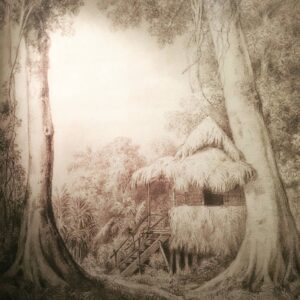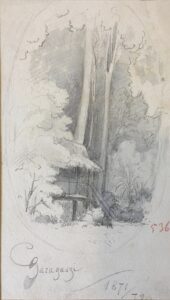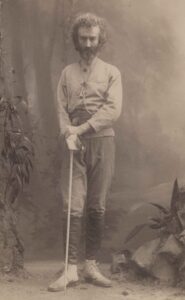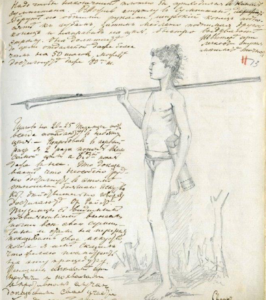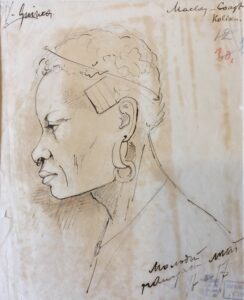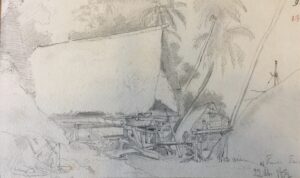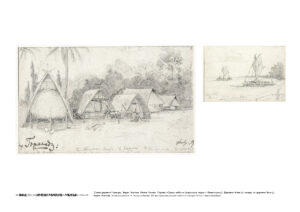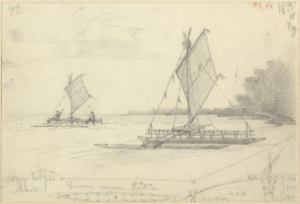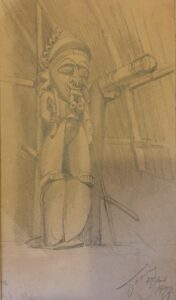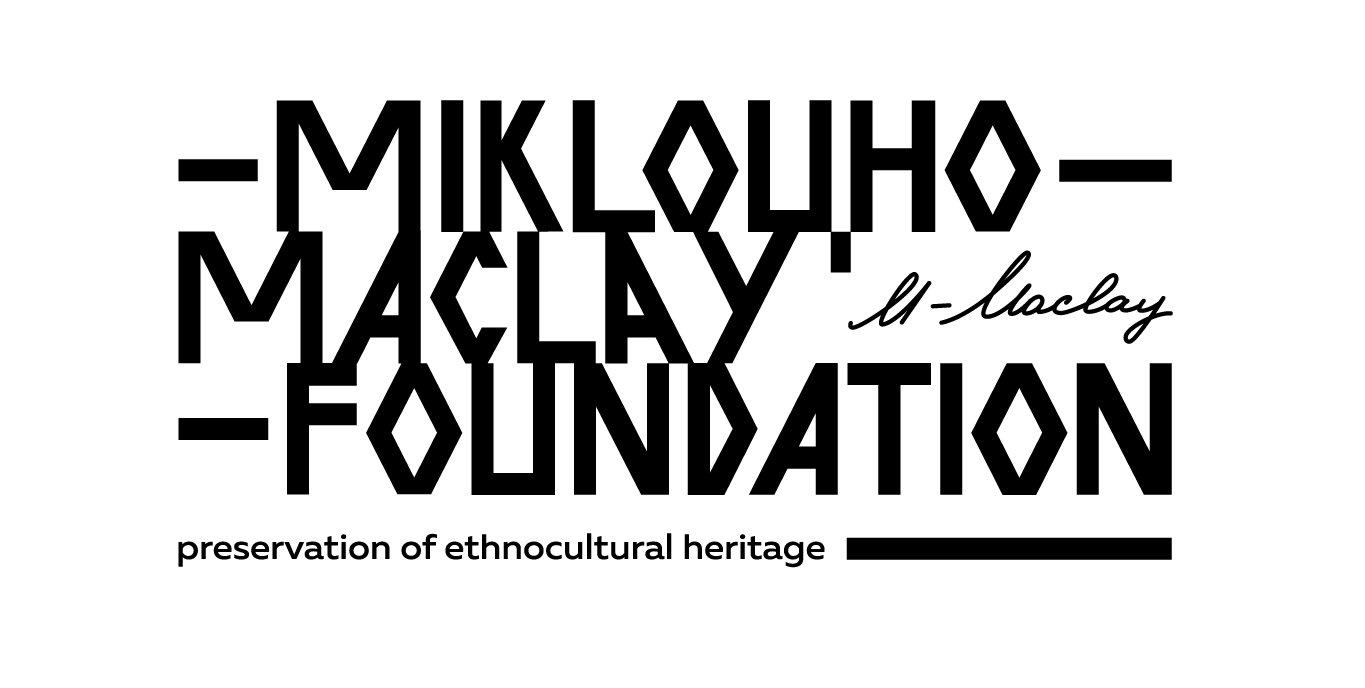Travels and scientific research in Oceania by N. N. Miklouho-Maclay (1871–1883)
Travels and scientific research of N. N. Miklouho-Maclay were an important milestone in the history of Russian science. Especially significant was his contribution to the ethnography of New Guinea and other islands in Oceania.
In the second half of the XIX century, Russian research in Oceania was closely connected with the name of an outstanding scientist, traveler, humanist, and public figure, N. N. Miklouho-Maclay (1846–1888).
Nikolay Nikolaevich Miklouho-Maclay was born on 17 July 1846 in Yazykovo-Rozhdestvenskoye village of Borovichsky Uyezd, Novgorod Governorate. Already during his study in Gymnasium, he awakened an interest in natural history and geography. In September 1863, Nikolay Nikolaevich was admitted to the Natural Sciences Department of the Faculty of Physics and Mathematics, Saint-Petersburg University, but in February 1864 he was expelled for participation in student meetings. After that the future scientist went to Germany to continue his education. During his study at the Faculty of Medicine he was strongly influenced by Ernst Haeckel, professor of zoology and distinguished evolutionary biologist. Making his early zoological expeditions, Miklouho-Maclay was vividly interested in the culture and customs of the peoples whose territories he visited (Morocco, Spain, the Red Sea coast), leaving valuable ethnographic notes.
And his further scientific activity was more connected with the ethnographic and anthropological study of the peoples little studied at that time. In the history of ethnological science Nikolay Nikolaevich entered as the discoverer of the cultures of New Guinea, especially its northeastern part. Prior to his expeditions, the population of this vast island was often rather vague and unclear, despite the fact that Europeans had known this land since the XVI century.
A particularly significant event in his life was the first stay on the coast of Astrolabe Bay (later called Maclay Coast) in the North-East of New Guinea, from 20 September 1871 to 24 December 1872. On the way to this island, the corvette "Vityaz", on which Miklouho-Maclay traveled, visited the following islands: Easter Island, Pitcairn, Mangareva, Tahiti, Samoa, Rotuma, New Ireland. The Russian scientist left though brief, but very interesting notes about these places. In New Guinea, Miklouho-Maclay found himself among the people of the Stone Age, who did not know metals, who at first treated the stranger as some kind of supernatural being. They signaled to the scientist to leave and threatened to kill him. But the traveler did not react to their actions, did not show aggression and walked everywhere unarmed. Thanks to his circumspection, restraint and patience, he managed to overcome the wariness of the indigenous people (Papuans). As Maclay wrote, "Things are going well; my policy of patience and noninterference seems to have been quite correct. I do not go to them, but they come to me. I do not ask them for anything, but they ask me, and they are even beginning to wait on me".
In addition, Miklouho-Maclay's medical background also played an important role: he successfully treated the indigenous people (Papuans), who began to turn to him for medical help. Five months after his arrival, a turning point in relations occurred; the islanders stopped shunning him, began inviting him to the so-called men's houses, where ritual items were kept, and to the night celebrations that took place in the forest. But they continued to consider the Russian scientist a mythical creature, though not evil (as in other parts of the world, the indigenous people (Papuans) divided supernatural beings into good and evil), but a creature of good deeds. Maclay did not refute these beliefs, but even supported them because they provided him with security and unquestionable authority, which created more favorable conditions for scientific research. Miklouho-Maclay managed to collect a wealth of ethnographic and anthropological material on the inhabitants of some villages of the Maclay Coast.
In addition, he managed to learn the local Papuan language, Bongu, which allowed him to delve even deeper into the local culture. Leaving Astrolabe Bay at the end of 1872, Miklouho-Maclay decided to continue studying the indigenous people of New Guinea. During his subsequent expeditions, he visited the Maclay Coast twice more (in 1876-1877 and 1883). He has spent a total of 30 months there. The scholar also visited parts of the southwestern coast (Papua Koviai in 1874) and southeastern coast of New Guinea and the islands adjacent to New Guinea. In addition, during his many voyages he made extensive studies of peoples and cultures in other parts of Melanesia: New Caledonia and the Loyalty Islands, Vanuatu, the Solomon Islands, the Admiralty Islands, and the Western Isles. In Micronesia, Miklouho-Maclay visited the islands of Palau, Yap, Eauripik Island and Ulithi.
During his short life Nikolay Nikolaevich managed to make significant contributions to a variety of scientific disciplines. In the fields of physical anthropology and ethnology it can be fairly stated that it was N. N. Miklouho-Maclay who "discovered" to the outside world the indigenous people (Papuans) of the Maclay Coast (northeastern part of New Guinea) by conducting a detailed study of their anthropological type, material culture, everyday and social life. The scientist showed how untenable the racist views of some anthropologists about the "tuft-like" hair growth and the "roughness" of the Papuan skin were. While visiting Papua-Koviai, Miklouho-Maclay correctly noted the admixture of "Malay blood" among the local Papuan anthropologic type, which was a direct reflection of the long-standing trade relations between the inhabitants of this part of New Guinea and the inhabitants of Southeast Asia. During his expedition to the southeastern coast of New Guinea, Nikolay Nikolaevich also pointed out a weakening of the australoid features in some representatives of the local population, which was expressed in a lighter complexion and straight hair. N. N. Miklouho-Maclay attributed this circumstance to the small-scale Polynesian migration to this area of the island. Indeed, ethnic groups in some areas of the coasts of southeastern New Guinea, as well as the islands of the Massim area (Trobrian Islands, etc.) have a noticeable Mongoloid admixture, but this is most likely due to the migrations to these areas from eastern Indonesia about 1500 years ago.
During his short stay in the Western Micronesia - on the islands of Palau and Yap - Nikolay Nikolayevich made valuable notes on some interesting customs of the natives (for example, the custom of artificial pressing the nose of a new-born baby on the Yap islands) and some elements of their religious beliefs and mythological notions. His descriptions of anthropological peculiarities of the inhabitants of these island groups are of no small importance. For example, in the Palau Islands, he identified the presence of Papuan admixture (i.e., traits of the Australoid race) among the islanders, but according to his descriptions it is present in the Yap Islands, which is in perfect agreement with the later anthropological and genetic studies in this region. During his visit to North-Western Melanesia (Admiralty Islands, Western Isles), Miklouho-Maclay also collected important ethnographic and anthropological material. Particularly noteworthy is his study of the Hermit Islands (part of the Western Isles), where he stayed for only three days, but during that time he managed to gather a lot of information on both the traditional culture and the physical appearance of the indigenous inhabitants of this little-known group of islands.
As for the biological sciences, the views and formulations of the young student Miklouho-Maclay on the nature of sponges were much closer to modern scientific views than those of his teacher Ernst Haeckel. Based on his studies of the sponges of the northern and far-eastern seas on the one hand and of the Red Sea on the other hand, Miklouho-Maclay noted the special richness of the Red Sea in calcareous sponges and of the northern seas in siliceous sponges. Later studies fully confirmed the rightness of Nikolay Nikolaevich: for the cold seas of the northern and southern hemispheres four-axial siliceous sponges of the family Polymastiidae are particularly characteristic. In 1881, N. N. Miklouho-Maclay founded in Watson's Bay (New South Wales, Australia) the first marine biological station in the southern hemisphere, where he conducted his scientific research. It is worth noting that thanks to the ideas of Miklouho-Maclay the first Russian biological station in Sevastopol was founded. As a biologist, Nikolay Miklouho-Maclay was an evolutionist, although he never advertised himself as such and avoided arguments on theoretical topics. But the evolutionary point of view, the belief in the unlimited ability of organisms, especially inferior organisms, to change under the influence of external conditions can be traced in all the works of the scientist, from his youthful studies of sponges to the study of the organization of heterodont sharks. Like most of his contemporaries, Miklouho-Maclay argued in favor of hereditary transmission of acquired characteristics. N. N. Miklouho-Maclay's considerable merit as a scientist also lies in the field of earth sciences, in particular, volcanology, meteorology, oceanology and geothermy. When Miklouho-Maclay and the Russian sailors visited the northeastern part of New Guinea, they mapped about 50 names of geographical objects of the region.
After the German colonial rule in this part of New Guinea a large part of the Russian toponyms were renamed. During the Australian rule some names were changed too. For example, the Maclay Coast is now called Rai Coast (according to the locals, after one of the villages of the same name). As a social activist, Miklouho-Maclay actively fought against the slave trade and colonial occupations in the South Pacific. His plans included the creation of the so-called "Papuan Union" and the Russian volunteer settlement on the Maclay Coast (northeast of the New Guinea Island). In addition, he proposed the establishment of a Russian settlement in an island group (he called "Group M"), not occupied by other powers (most likely, it was a Micronesian atoll Makin, located in the northern part of the Kiribati Archipelago). However, all these plans of the scientist were not destined to fulfil, and despite the support of the Russian Emperor, who personally supported Miklouho-Maclay's undertakings, due to the impossibility to quickly control the distant lands of Miklouho-Maclay, he was refused.
Список литературы
Колесников М. Миклухо-Маклай. М., 1965.
Миклухо-Маклай Н. Н. Собрание сочинений. В 6 т. М., 1990–1999.
Тумаркин Д. Д. Белый папуас. Н. Н. Миклухо-Маклай на фоне эпохи. М., 2011.
Here is a list of toponyms mapped during these expeditions:
Rai Coast (Maclay Coast)
Baer Ridge
Grand Duke Konstantin Mountain (Gora velikogo knyazya Konstantina)
The Grand Duchess Mountain (Gora velikoi knyagini Eleny)
The Grand Duchess Elena Strait
Gorchakov Mountain
Archipelago of Contented Men
Izumrud Strait
Kant Mt.
Selat Namatote (Queen Sophia Strait)
Cape Loudon
Meshchersky Mountain
Peter the Great Mountains (1st peak)
Peter the Great Mountains (2nd peak)
Sek Harbour (Alexis Harbour)
Garagassi Point (Cape Solitude, rus. Mys Uedineniya)
Schopenhauer Mt.

